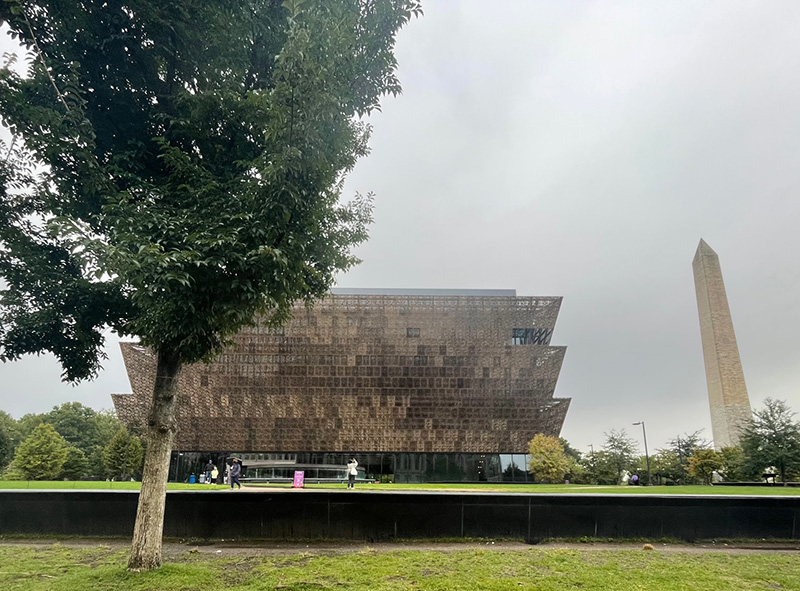
A Message from the Strategist
“A democracy cannot thrive where power remains unchecked, and justice is reserved for a select few. Ignoring these cries and failing to respond to this movement is simply not an option — for peace cannot exist where justice is not served.” — John Lewis
It is with esteemed pleasure that I present EDI’s 2023 Black History Month Campaign!
This year’s theme, Black Resistance - Equality Through Justice reveres the historical past of Black people and their unyielding determination for equality in the pursuit of justice – in the Nation we have helped to build.

Kiana Atkins
Principal Strategist
Black Employment Portfolio
Adinkra Symbols

Adinkra symbols are the creation of Gyaman King Nana Kwadwo Agyemang Adinkra. Adinkra symbols are used in textiles, logos, and pottery. While the symbols serve as aesthetic elements, they also broadly represent objects that hold emotive ideas about ancient wisdom, life, and the environment. There are also a variety of symbols with varied meanings that are frequently associated with proverbs.
Above is one of Adinkra’s symbols, Epa, which signifies law and justice.

EDI encourages you to visit the Smithsonian National Museum of African American History and Culture. Explore the NMAAHC initiative on Black resistance.
Events

The Psychological Impact of Code-Switching
Wednesday, February 8, 2023 | 12:00 pm to 1:00 pm EDT
Hosted by Kiana Atkins, Principal Strategist for the Black Portfolio
&
Patricia Sauceda Kramer, Principal Strategist for the Hispanic/Latino/a/x Portfolio
Join us for a Fireside Chat Featuring: Dr. Jean Lud Cadet and Mr. Kevin Williams, Esq. as they discuss the Psychological Impact of Code-Switching.

The Black Resistance, Achieving Equality Through Justice
Wednesday, February 15, 2023 | 12:00 pm to 1:00 pm EDT
Hosted by Kiana Atkins, Principal Strategist for the Black Portfolio
&
Patricia Sauceda Kramer, Principal Strategist for the Hispanic/Latino/a/x Portfolio
Please join the Office of Equity, Diversity, and Inclusion as we hear from panelists: Dr. Juanita Chinn, Dr. Mia Rochelle, and Dr. Valerie Maholmes, as they discuss Black Resistance in all forms, what this means to them, its history and how the Black Resistance has paved the way to “Equality through Justice.”
Featured Blogs
Supporting Black, Indigenous, and People of Color (BIPOC) in the Workplace: In this four-part blog series, we share information and resources to help BIPOC and allies understand various workplace phenomena and explore recommendations to help mitigate these issues and explain what leaders can do to support BIPOC.
Where you see wrong or inequality or injustice, speak out, because this is your country. This is your democracy. Make it. Protect it. Pass it on.
— Thurgood Marshall, 1978 University of Virginia commencement speech
About the Hero Image
The 2023 Black History Month Hero Image pays homage to Bisa Butler’s quilted portrait of Harriet Tubman titled, “I Go to Prepare A Place For You,” that is currently featured in the Smithsonian National Museum of African American History and Culture (NMAAHC)’s new exhibit, “Reckoning: Protest. Defiance. Resilience.”
Despite its vivid use of color and shade, Butler explains “there is zero paint on this artwork.” The portrait is a 93” x 90” inch textile made of cotton, silk, wool, and velvet quilted and appliquéd.
According to the NMAAHC, “the quilt depicts Tubman, in multiple bright-colored fabrics, seated against a dark floral background. Tubman gazes directly at the viewer, her proper right arm on the back of the chair and her proper left hand in her lap. Her face and hands are shown in contrasting shades of blue and purple with rich reds, symbolizing Tubman’s coolness, calmness, and strength as well as her power and force. Her hair is made of a deep velvet cloth, soft and opulent to mimic the soft texture of some African American hair.” Additionally, “at bottom center of this section is an orange lion, an embodiment of Tubman herself.” Surrounding the center section is Tubman’s skirt patterned with gold and orange ferns and palm fronds against a green background. The colors symbolize Tubman’s African heritage, with the thick foliage at the bottom of the skirt gradually opening to a clearing at the top to signify a journey from turmoil to freedom. Along the hem of the skirt is an orange wave design representing pain and turmoil. The small seeds growing upwards to become vibrant flowers commemorates strong women. The pleats or stripes on the skirt are evocative of the fields of crops where Tubman labored. Black and white kente fabric compose “the chair upon which Tubman is seated, suggesting a royal throne, and paying homage to the artist’s Ghanaian heritage...”
To further pay reverence to the 2023 Black History Month theme, “Black Resistance-Equality Through Justice,” as well as Bisa’s original artwork, the Hero Image primarily uses the NMAAC’s purple brand color, and features the Ghanian symbol “Epa” (Equality, Law, and Justice) to speak to both the campaign theme and Tubman’s ancestry.














